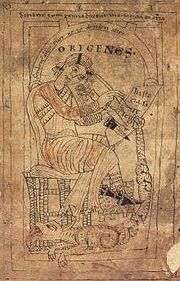
Theological Library of Caesarea Maritima
Encyclopedia

History
Through Origen and especially the scholarly presbyter Pamphilus of CaesareaPamphilus of Caesarea
Saint Pamphilus , was a presbyter of Caesarea and chief among Catholic Biblical scholars of his generation...
, an avid collector of books of Scripture, the theological school of Caesarea won a reputation for having the most extensive ecclesiastical library of the time, containing more than 30,000 manuscripts: Gregory Nazianzus, Basil the Great, Jerome
Jerome
Saint Jerome was a Roman Christian priest, confessor, theologian and historian, and who became a Doctor of the Church. He was the son of Eusebius, of the city of Stridon, which was on the border of Dalmatia and Pannonia...
and others came to study there. The Caesarean text-type
Caesarean text-type
Caesarean text-type is the term proposed by certain scholars to denote a consistent pattern of variant readings that is claimed to be apparent in certain Greek manuscripts of the four Gospels, but which is not found in any of the other commonly recognized New Testament text-types; the Byzantine...
is recognized by scholars as one of the earliest New Testament
New Testament
The New Testament is the second major division of the Christian biblical canon, the first such division being the much longer Old Testament....
types.
St Pamphilus devoted his life to searching out and obtaining ancient texts which he collected in the famous library that Jerome
Jerome
Saint Jerome was a Roman Christian priest, confessor, theologian and historian, and who became a Doctor of the Church. He was the son of Eusebius, of the city of Stridon, which was on the border of Dalmatia and Pannonia...
was later to use, and established a school for theological study. In the scriptorium
Scriptorium
Scriptorium, literally "a place for writing", is commonly used to refer to a room in medieval European monasteries devoted to the copying of manuscripts by monastic scribes...
, a necessary adjunct to all libraries of antiquity
Ancient history
Ancient history is the study of the written past from the beginning of recorded human history to the Early Middle Ages. The span of recorded history is roughly 5,000 years, with Cuneiform script, the oldest discovered form of coherent writing, from the protoliterate period around the 30th century BC...
, he oversaw the production of accurate edited copies of Scripture. Testimonies to his zeal and care in this work are to be found in the colophon
Colophon (publishing)
In publishing, a colophon is either:* A brief description of publication or production notes relevant to the edition, in modern books usually located at the reverse of the title page, but can also sometimes be located at the end of the book, or...
s of biblical manuscripts. Jerome's "De Viris Illustribus
De viris illustribus
De viris illustribus, meaning "On Illustrious / Famous Men", represents a trope of ancient Roman exemplary literature that was revived during the Italian Renaissance and inspired the assembly or commissioning of series of portraits of outstanding men— and sometimes, by the sixteenth century, of...
" (75) says that Pamphilus "transcribed the greater part of the works of Origen of Alexandria with his own hand," and that "these are still preserved in the library of Cæsarea."
Among other priceless lost treasures in the library, was the Gospel according to the Hebrews. Jerome knew of this copy of the so-called "Hebrew" or Aramaic text of the Gospel of Matthew and Eusebius refers to the catalogue of the library that he appended to his life of Pamphilus. A passage from the lost life, quoted by Jerome, describes how Pamphilus supplied poor scholars with the necessaries of life, and, not merely lent, but gave them copies of the Scriptures, of which he kept a large supply. He likewise bestowed copies on women devoted to study. The great treasure of the library at Caesarea was Origen's own copy of the "Hexapla
Hexapla
Hexapla is the term for an edition of the Bible in six versions. Especially it applies to the edition of the Old Testament compiled by Origen of Alexandria, which placed side by side:#Hebrew...
," probably the only complete copy ever made. It was consulted by Jerome. St Pamphilus was martyred in February, 309.
The collections of the library suffered during the persecutions under the Emperor Diocletian
Diocletian
Diocletian |latinized]] upon his accession to Diocletian . c. 22 December 244 – 3 December 311), was a Roman Emperor from 284 to 305....
, but were repaired subsequently by bishops of Caesarea. Acacius of Caesarea
Acacius of Caesarea
Acacius of Caesarea in Greek Ἀκάκιος Mονόφθαλμος was a Christian bishop, the pupil and successor in the Palestinian see of Caesarea of Eusebius AD 340, whose life he wrote. He is remembered chiefly for his bitter opposition to St. Cyril of Jerusalem and for the part he was afterwards enabled to...
and Euzoius, successors of Eusebius concentrated on conservation.
It was noted in the 6th century, but Henry Barclay Swete
Henry Barclay Swete
Henry Barclay Swete was an English Biblical scholar. He became Regius Professor of Divinity at Cambridge in 1890. He is known for his 1906 commentary on the Book of Revelation, and other works of exegesis....
was of the opinion that it probably did not long survive the capture of Caesarea by the Saracens in 638, and this scholarly consensus is echoed by more modern historians: the “large library [30,000 vols in A.D. 630 {O’Connor 1980:161}] survived at Caesarea until destroyed by the Arabs in the 7th cent.”

